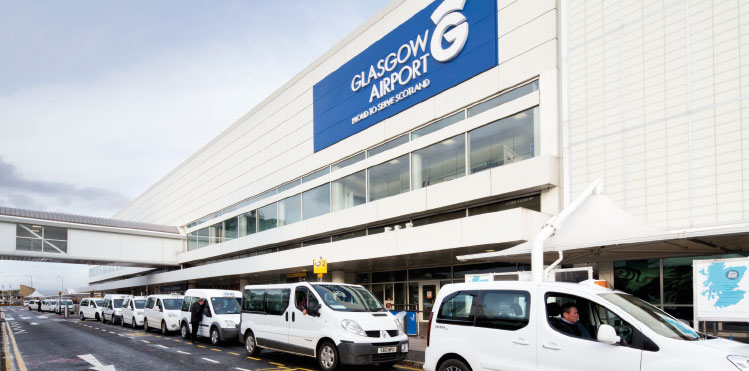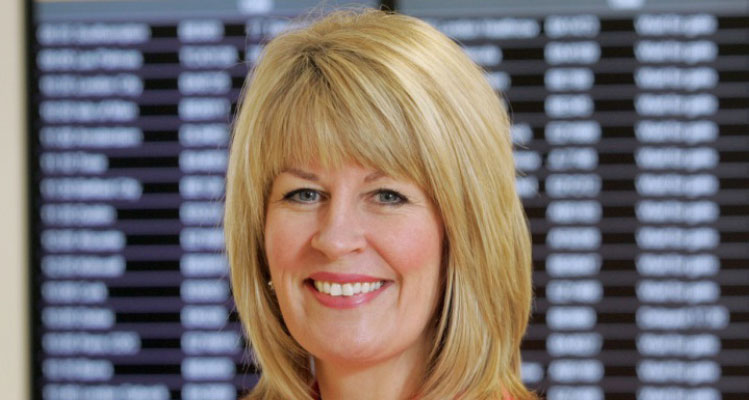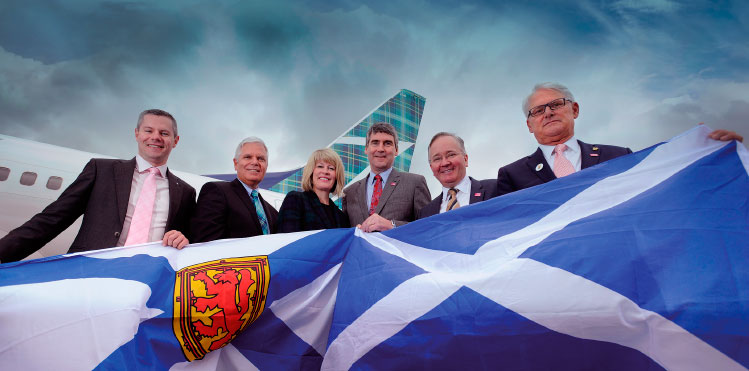
Amanda McMillan, Managing Director, Glasgow Airport, and CEO, AGS Airports: “Our overarching vision is to be Scotland’s preferred business and leisure airport. We aim to achieve this by developing a strong and lasting route network, continuing to invest in our facilities and delivering an unrivalled customer experience.”
The events of the last year have seen the eyes of the world fixed on Glasgow and, as its tourism industry continues to flourish, its airport is presented with the auspicious opportunity to grow with the city. Amanda McMillan, Managing Director, Glasgow Airport, and CEO, AGS Airports, explained the airport’s strategy to Amy Hanna.
The first half of 2015 has been a fruitful time for Glasgow Airport. Since just before the airport was acquired by Ferrovial and Macquarie to become part of AGS Airports Limited at the end of last year, it has seen double-digit growth in monthly passenger numbers, bolstering the sustained growth in throughput it has been experiencing since January 2011. The airport recorded its busiest ever April this year, when 665,000 passengers travelled through its doors, representing an increase of 15.4% on the same period last year. There was also a marked increase in both international and domestic traffic, which grew by 20.4% and 10.9% respectively, making April its 26th consecutive month of growth.
There are a number of factors to which Glasgow’s growth can be attributed, but arguably the main driver is a renewed confidence in the airport – amongst passengers and airlines alike. The arrival of airlines such as Ryanair and WestJet, coupled with the decision by its existing airline partners to add further capacity, has undoubtedly helped persuade more and more people to fly from Glasgow. “The challenge,” began Amanda McMillan, Managing Director, Glasgow Airport, “as always will be to sustain this growth, but we are in a very strong position. Our efforts will be aided by the welcome announcement that Air Passenger Duty is to be devolved to Scotland. Giving the Scottish Parliament full control over APD will play a major role in strengthening our connectivity and it is vital this is progressed as soon as possible. Not only will it ensure our tourism industry can continue to flourish, it will enable us to truly leverage the opportunities presented by the major events that raised Scotland’s global profile throughout 2014.”

Amanda McMillan, Managing Director, Glasgow Airport, and CEO, AGS Airports: “We expect our passenger numbers for 2015 to step comfortably above eight million and put us on track to achieve nine million. We want to continue to add destinations to our route map, and this includes ensuring we have enough capacity to London and the UK regions.”
Growing connectivity
2014 too was a landmark year for Glasgow, and one that symbolised significant change for both the airport and the city. It was the gateway’s fourth consecutive year of passenger growth, in which it served 7.7 million passengers – an annual increase of 4.8%, and its busiest since 2008. The airport also completed a £20 million investment programme ahead of a series of major international events including the Commonwealth Games, the MTV European Music Awards, and the Ryder Cup, all of which ensured the eyes of the world fell on the city of Glasgow. “All of these events have supported our efforts in route development by raising the profile of the city,” McMillan said. “It is important we continue to leverage these opportunities by developing compelling propositions for airlines to ensure they choose Glasgow over competing markets.”
Glasgow has, therefore, been left with a tremendous legacy, and in 2015 the city will once again open its doors to the world to host the prestigious Turner Prize, the IPC Swimming World Championships and the World Gymnastics Championships.
The emerging prominence of the city on the global stage is one of many reasons why airlines are now clamouring to fly to Glasgow – a city described as the economic powerhouse of Scotland. The city’s burgeoning tourism trade is also a contributing factor, and the airport has cultivated successful relationships with regional and national bodies such as Glasgow City Marketing Bureau and VisitScotland to tell the city’s story and further promote the region’s and Scotland’s international standing. “This partnership approach is hugely effective, and together with our partners we will continue to vigorously pursue new routes,” McMillan commented. “It has already yielded hugely positive results and in 2015 alone we will launch 20 new routes, including direct flights to Halifax, Nova Scotia; Las Vegas; Cuba; Bordeaux; Munich; Prague and Budapest. We have always been extremely proud of our position as Scotland’s leading long-haul airport, so the addition of further long-haul flights has been particularly pleasing.”

In May of this year Canadian airline WestJet opened its first UK base when it launched direct flights between Glasgow and Halifax, Nova Scotia. Derek Mackay MSP; Gregg Saretsky, CEO of WestJet; Amanda McMillan, Managing Director, Glasgow Airport; Stephen McNeil, Premier of Nova Scotia; Cllr Gordon Matheson, Leader of Glasgow City Council; and Gordon Campbell, Canadian High Commissioner to the UK, commemorated the inauguration of the airline’s second transatlantic service.
Glasgow’s low cost carriers including Ryanair, Wizz Air and easyJet, its biggest carrier, have also strengthened its connectivity with a number of European cities. In April, Wizz Air made a series of announcements including the launch of direct flights to Budapest, Vilnius and the Polish city of Lublin. Ryanair now serves 10 destinations including Warsaw, Berlin and Riga, while easyJet has added Bordeaux, Dubrovnik and Marrakech. Not to be outdone, Jet2.com has continued to add capacity, and the addition in May of a sixth-based aircraft cemented Glasgow’s position as the airline’s largest Scottish base, with new flights added to Prague, Malta and a number of sun destinations. “Taking all of these developments together we expect our passenger numbers for 2015 to step comfortably above eight million and put us on track to achieve nine million.”
“We want to continue to add destinations to our route map, and this includes ensuring we have enough capacity to London and the UK regions,” McMillan furthered. “It’s for this reason that we have a vested interest in the ongoing debate on whether to build a new runway at Heathrow or Gatwick. This decision is not just about London and Surrey, it has significant implications for Scotland.” The Airports Commission is examining how airport capacity can be expanded to improve links to the rest of the world for businesses and travellers from all the countries and regions of the UK, not least Scotland. “At the heart of the challenge is the need to ensure we have a world-class hub airport which can meet demand for new routes to emerging markets both now and in the future.”
Growing infrastructure
The airport has recently completed the extension of its east pier, a development embarked upon in direct response to its success in securing a number of new routes and services. Not only has it significantly enhanced the airport’s facilities, it will improve the passenger experience for the millions of people who travel through its doors every year. “The £3 million project involved the construction of a two storey, 1,400sqm extension to the pier which serves airlines including Ryanair and easyJet. It also resulted in the creation of a spacious and modern gate room for departing passengers,” McMillan described. “Importantly, the extension provides us with the flexibility to accommodate and respond to further growth. It also reflects the modern fleet employed by airlines. The East Pier includes a pier served Code E stand bringing our total number of Code E stands to six. Long-haul travel is where we see our growth and that is why it is vital our investment plans are aligned with the long-term business strategy.”







